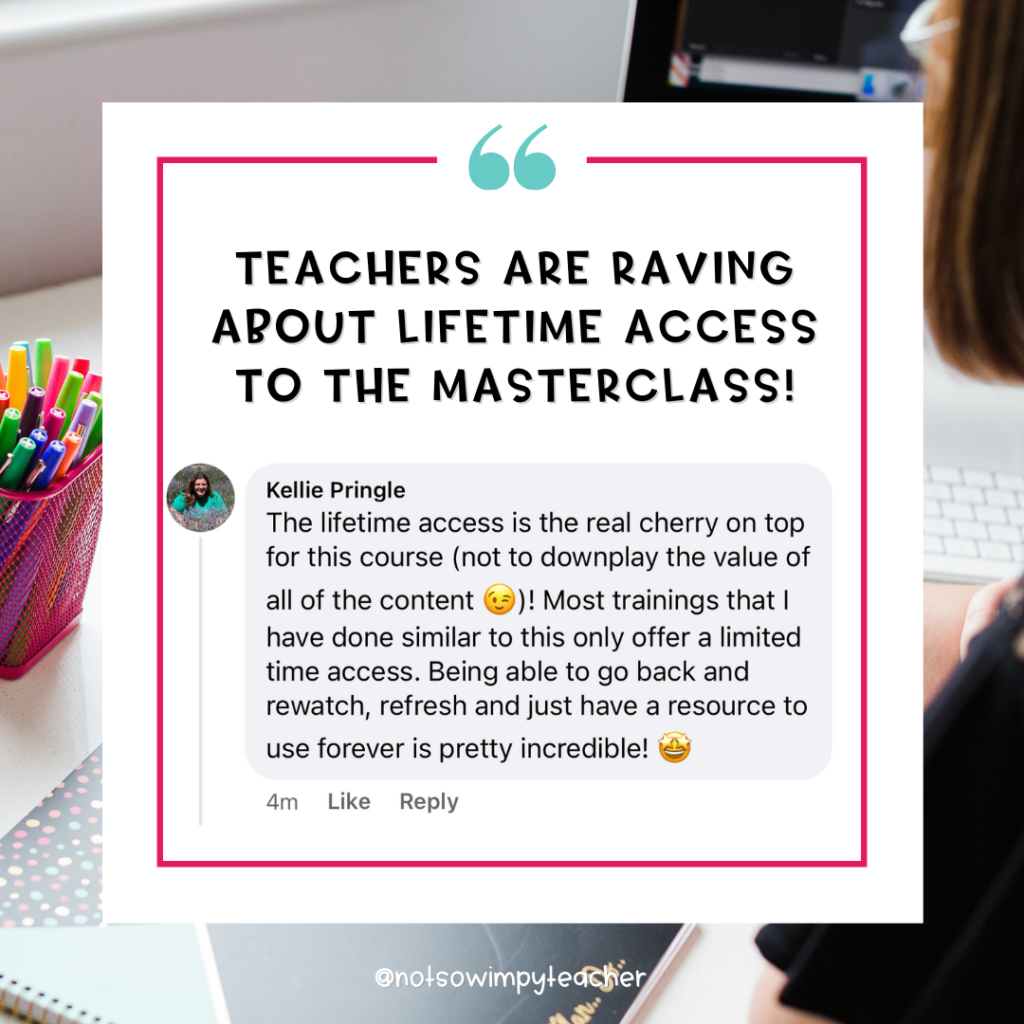
One Change You Need to Make to Your Writing Workshop
Teaching writing is HARD. I never took a formal class about how to teach writing and most of my students came to me already disliking writing. I didn’t know how to get my students to love writing and to meet all of their unique needs when it came to their writing skills. My writing block felt disappointing. Until I made one simple change…

The Typical Writing Workshop
In the typical writing workshop model, your students are at all different places in the writing process. Some students might be planning, others drafting, a few pretending to revise and edit, some publishing and the rest are doodling or staring at the clock.
As a teacher, it is very difficult to decide what mini lesson to teach each day because your students have very different needs based on where they are in the writing process.
For example, you might decide to teach a lesson about how to revise your lead to be more interesting. It might be one of your best mini lessons, but only a few students really need that skill on that day. Students who are planning, editing or publishing won’t use the strategies that you just taught. And we all know what happens when students do not immediately use the strategies…they are forgotten.
Another downside to students all being at different places in the writing process is that it is difficult to support them during conferences or independent writing time. You have to help one student figure out how to log in to his Google doc, support another student who doesn’t know what to write about, monitor partners who are supposed to be doing a peer edit, and handle a whole series of other issues that pop up. It feels like a three ring circus where you are madly dashing around the room.
Does this all sound about right?
A Simple Change to Your Writing Workshop
I needed all of my students to be at the same place in the writing process. This would make it easier for me to support my writers and my students would be able to implement lessons immediately. We all needed to be drafting at the same time. Then we could all revise together and so on.
But, how do you do this when every student writes at a different pace?
The answer? The masterpiece!
This one change completely transformed my writing workshop by decreasing the chaos and increasing the confidence of my writers.
Every day we would start with a ten-minute mini lesson on a very specific skill that I wanted students to use in their writing. First, we would do lessons about how to generate a writing topic. After they drafted, we would do short lessons on revising their lead, small moments, dialogue, etc. We would continue through the writing process with one mini lesson at a time.
At the end of the mini lesson, students were given a very short writing task to complete that was entirely based on the mini lesson from that day. They were implementing what I was teaching right away! For example, if I taught a mini lesson about strong opinion statements, their task might be to revise their opinion statement to be stronger. They were just being asked to work on revising one sentence!
The task took writers less than ten minutes but made a huge difference in the effectiveness of their writing. This removed so much of the pressure that came with being told to “go write.” They have a very specific task and this increases your writers’ confidence.
Every day this piece of writing (which I refer to as the masterpiece) will get better as students complete the daily task.
Now all students are at the same place in the writing process and implementing mini lesson strategies every single day. It was so much easier to support all of my writers!

Fast Finishers
I still had one problem. My writers still wrote at a different pace. This meant that everyone did not finish their daily task at the same time.
If a student completed their task early, I didn’t want them to just continue working. Doing so would mean that everyone was no longer at the same place in the writing process.
Instead of continuing to work on their masterpiece, students who were fast finishers would flip to the back of their notebook and work on a different story or report. Most students actually had two different stories or reports going at one time! And it worked.
I had two very simple rules for these extra stories:
- The story had to be in the same genre that we were currently working on. If we were in the middle of our personal narrative writing unit, then their extra piece needed to be personal narrative as well.
- Students needed to attempt to use all of the skills and strategies that we had learned in the mini lessons.
But here is my secret- I didn’t grade these extra pieces of writing. They were just extra practice for my writers! But, most importantly, the extra stories kept all of my writers at the same place in the writing process for their masterpiece. The extra stories could then be completed at their own pace.

Join the Writing Masterclass
This strategy is part of the Not So Wimpy Writing Process that is taught by my good friend Jamie from Not So Wimpy Teacher. She teaches this strategy and so many others in her online professional development course for teachers in grades 2-5.
The Not So Wimpy Writing Masterclass is a self-paced professional development program that teaches you, step-by-step, how to become a successful writing teacher who inspires students and transforms them into great writers.
And the best part? Jamie will teach you how to make teaching writing EASY!
This program is only available online–which makes it the best darn professional development you could ever take. Why? Because you don’t have to dress up, wear makeup, or do your hair in order to participate! You can watch (or listen) while wearing your pajamas, going on your run, or driving to pick up the kids from badminton practice–nobody will know but you!
The Not So Wimpy Writing Masterclass gets results. By the end of this program, you will have learned how to:
- Turn your students into skilled writers who love writing so much, they beg for more writing time!
- Follow a process for teaching writing that makes it simple, effective, and even joyful to teach writing.
- Create manageable mini lessons to teach.
- Find time every day for writing instruction and weekly conference time for all of your students.
- Help your students get the skills they need to perform well on standardized tests.
- Take all the mystery, overwhelm, stress, and anxiety out of teaching writing.
Click HERE if you’re feeling like “YES! I want to make writing easy to teach!“
